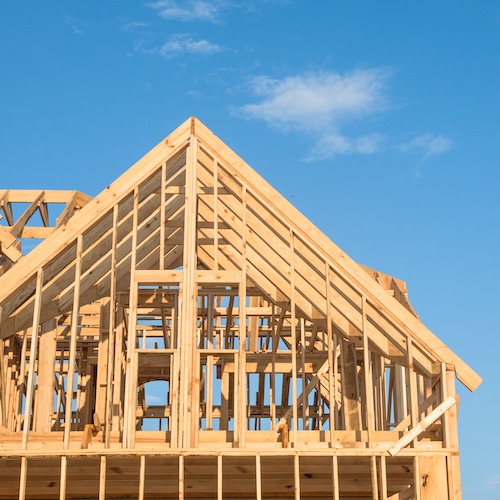FHA Construction-to-permanent loans: A guide
Contributed by Karen Idelson
Nov 22, 2025
•7-minute read

A construction-to-permanent loan is a single loan that covers the cost of building a home and then converts to a traditional mortgage once it’s done. An FHA loan is a government-backed loan that’s guaranteed by the Federal Housing Administration, so it can come with looser eligibility requirements. The FHA also offers construction-to-permanent loans for buyers looking to build a home who may not have the best credit. Here’s a closer look at how FHA construction-to-permanent loans work and the pros and cons of using one to build a home.
What Is an FHA Construction-to-Permanent Loan?
An FHA construction-to-permanent loan is an FHA loan that you can use to build a home. This type of loan combines the purpose of a construction loan and an FHA mortgage into a single loan option that covers both building and mortgage financing. That way, you only have to close once to buy the land, build the home, and get a mortgage.
An FHA construction-to-permanent loan will cover the costs of:
- Buying land
- Building materials
- Labor
- Any necessary permits
Like a typical FHA loan, an FHA construction-to-permanent loan is backed by the FHA to help make homeownership more attainable for borrowers with a lower credit score and a lesser down payment. To get a conventional construction loan, you’ll typically need a credit score of at least 680. However, FHA construction loans are offered to borrowers with a credit score as low as 580. As with a traditional FHA loan, you can also get an FHA construction-to-permit loan for a down payment as low as 3.5%.
Rocket Mortgage does not offer construction loans, but we can help you convert one into a mortgage once the home is built.
FHA Construction Loan Options
Let’s look at what differentiates FHA construction-to-permanent loans from other types of financing for home construction.
Construction-to-permanent vs. construction-only loans
Construction-only loans just cover the cost of buying land and building the home. These are short-term loans that typically only have a term of 12 – 18 months. Buyers must then repay the loan or convert it into a new mortgage. With this option, you’ll end up closing on two different loans, one to build the home and then one to purchase it once it’s done.
Construction-to-permanent loans cover the cost of the land, building materials, and labor. But unlike a typical construction loan, you don’t have to pay the funds back at the end of a short loan term. Instead, the loan automatically converts into a traditional mortgage with a loan term of 15 – 30 years. This option can help a buyer save money by avoiding having to pay closing costs on a second loan.
FHA 203(k) rehab loans vs. FHA construction-to-permanent loans
Another type of loan offered by the FHA for home construction it the FHA 203(k) rehab loan. While construction-to-permanent loans are intended for building a new home, 203(k) rehab loans are for renovating an existing home. For example, suppose you want to buy an older home that’s a bit of a fixer-upper that needs some work. Both loan options allow buyers to roll in the building or renovation costs into one mortgage to avoid having to close on two separate loans.
Requirements and eligibility
Construction-to-permanent loans pose more risk to lenders than traditional mortgages. That’s because if a buyer defaults, the lender is stuck with a partially built home. As a result, lenders tend to have stricter eligibility requirements for this loan type. The good news is that FHA loans are backed by the government, which helps mitigate this added risk.
Here are some of the eligibility requirements borrowers need to meet to get an FHA construction-to-permanent loan:
- Down payment: At least 3.5% the purchase price.
- Credit score: Many lenders, including Rocket Mortgage, require a minimum credit score of 580. Some lenders offer FHA loans to borrowers with a credit score as low as 500, but you’ll need to make a minimum 10% down payment.
- Debt-to-income ratio: You’ll typically need a DTI that doesn’t exceed 43%, though there are some exceptions.
- Loan amount: FHA loan limits for 2025 are $524,225 in most areas and $1,209,750 in high-cost areas.
- Property: The property must meet FHA minimum standards to ensure the home is safe, structurally sound, and free of hazards.
- Contractor: You’ll need to hire a contractor who is approved by the FHA.
How the Process Works
If you think an FHA construction-to-permanent loan might be right for you, here’s how to get one.
Step 1: Budgeting and pre-approval
The first step toward getting an FHA construction-to-permanent loan is figuring out what you can afford. Keep in mind that building a home typically costs more than buying an existing home, and it’s not uncommon for a construction project to run over budget.
One way to help you figure out your budget is by getting approved by a lender. Preapproval is a letter from a lender that tells you how much they’re willing to lend you up to a certain amount. It’s not the same as a guaranteed loan offer, but it can help you get an idea of the kind of house you can afford to build. Be sure to compare estimates from a few different lenders to make sure you’re getting the best loan terms you can.
Step 2: Select a licensed builder
If you’re going to use an FHA construction-to-permanent loan, you’ll need to work with a licensed contractor who is approved by the FHA. As you research builders in your area, be sure to ask if they have experience working with FHA loans. They will need to be able to ensure that the finished home meets FHA property standards. Your contractor will also have to provide you with a one-year builder’s warranty to protect against potential issues with the home.
Step 3: Underwriting and closing
Once you’ve chosen a lender, they’ll begin the underwriting process. During underwriting, the lender will review your finances to confirm you meet eligibility requirements and can afford to repay the loan. Your lender will ask for bank statements, tax returns, W-2 forms, pay stubs, and other financial documents. If everything checks out, the lender will issue final approval, and you’ll close on your loan.
Step 4: Construction phase and draws
Once it’s time to start construction, the lender will typically release funds in installments as you progress through each stage. You’ll likely need to secure homeowners insurance when you start building. Even though you aren’t living in the property yet, this coverage will protect against liabilities that could happen while it’s being built.
Step 5: Completion, move-in, and conversion to repayment
Once the building process is complete and the house is done, it’s time to finally move in. At this point, your construction-to-permanent loan will convert to a typical mortgage to cover the money you borrowed to build the home.Pros and cons of construction-to-permanent loans
Some of the benefits of construction-to-permanent loans include:
- You get to customize your house to your taste and needs
- You can use one loan to cover both building and a mortgage
- You’ll save on closing costs
- Low down payment requirements
It’s also important to consider some of the potential drawbacks of construction-to-permanent loans, such as:
- Higher interest rates because the lender takes on more risk
- Building a home is often more expensive than buying
- Stricter eligibility requirements
- Your build could go over-budget or get delayed
- You’ll have to pay for mortgage insurance
Alternatives to FHA Construction-to-Permanent Loans
If you don’t think an FHA construction-to-permanent loan is right for you, you can consider the following options:
- Conventional construction loans: These loans have stricter eligibility requirements because they aren’t backed by the government. However, if you have a good credit score and a larger down payment, you could save money.
- HELOC: A home equity line of credit allows you to use your current home as collateral to borrow money to build a new one. One benefit of a HELOC is you can draw against it as needed, which can be helpful if you can’t predict in advance precisely how much you’ll need to borrow. However, a HELOC is a second mortgage, so if you can’t pay it back, you’ll risk foreclosure on your current home. Rocket Mortgage does not offer HELOCs at this time, but we’re here to help you consider your options.
- Cash-out refinancing: With a cash-out refinance, you pay off your current mortgage with a larger loan and withdraw the difference in cash. It’s a way to use the equity you have in your current home to build a new one.
FAQs
Here are the answers to some frequently asked questions about FHA construction-to-permenant loans.
Are there income limits on FHA construction-to-permanent loans?
No. There are no income limits, though FHA loans can be more expensive than conventional loans for borrowers with good credit and a decent down payment.
Do you have to pay mortgage insurance on FHA loans?
Yes, all FHA loans require you to purchase mortgage insurance.
What are FHA construction loan interest rates?
FHA construction loans typically come with higher interest rates than regular FHA loans because lenders are taking on more risk financing the build.
The bottom line
If you’re planning on building a home, an FHA construction-to-permanent loan can be a great way to combine the benefits of FHA loans and construction loans. If your credit isn’t great and you only have a small down payment, an FHA loan can help you qualify for financing. A construction-to-permanent loan can save you money by using one loan to finance both the construction and the purchase.
If you’re ready to see what you may qualify for, you can start your application with Rocket Mortgage today.
To qualify for this offer, you must meet all standard FHA eligibility requirements. In addition, your total mortgage payment, including taxes and insurance, cannot exceed 38% of your income, your debt-to-income (DTI) ratio cannot exceed 45%, and you must have 12 months of verifiable housing history immediately prior to your application, no late payments 30 days or greater in the last 12-months, and no derogatory marks on your credit report. Not available on jumbo loans. Asset statements may be needed, no more than 1 day of non-sufficient fund fees are allowed in the most recent 2 months prior to application. Additional restrictions/conditions may apply.
Refinancing may increase finance charges over the life of the loan.

Rory Arnold
Rory Arnold is a Los Angeles-based writer who has contributed to a variety of publications, including Quicken Loans, LowerMyBills, Ranker, Earth.com and JerseyDigs. He has also been quoted in The Atlantic. Rory received his Bachelor of Science in Media, Culture and Communication from New York University.
Related Resources

5-minute read
A guide to VA construction loans
VA construction loans can help veterans and active-duty service members finance and build their dream home. Explore VA construction loans and how they work.
Read more

5-minute read
USDA construction loan requirements: Everything you need to know
Learn USDA construction loan requirements, who qualifies, what to expect, and how one can help you buy land and build your dream home with a single loan.
Read more
9-minute read
Construction loans: Everything you need to know
Always dreamed of building a custom-tailored home? A construction loan could help to make that a reality. Learn what construction loans are and how they work...
Read more